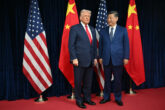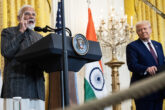
February 01, 2024
Military Artificial Intelligence, the People’s Liberation Army, and U.S.-China Strategic Competition
Watch:
Watch the full testimony here.
I. Introduction
Thank you Co-Chair Wessel, Co-Chair Helberg, and the Commissioners for inviting me to provide written and oral testimony on this critical topic.1 My comments draw on my own research as well as technical insights from my colleagues in CNAS’s Artificial Intelligence (AI) Safety and Stability Project (although the policy views are solely mine). It should be noted up front that this field poses special analytical challenges: it is mostly intangible, the technology is complex and evolving rapidly, and China’s applications of AI in a military context are still shrouded in secrecy.
My testimony covers China’s military applications of AI, as well as the broader geostrategic implications of AI development for U.S.-China major power competition. It starts by examining the role of AI in China’s overall military modernization plans. Then, it explores AI implementation to date in China’s military, the People’s Liberation Army (PLA). Next, my testimony considers obstacles that could block the PLA from reaching its military AI ambitions and explores some of the risks that military AI could pose in the U.S.-China security relationship. Finally, my testimony assesses U.S. responses to date and offers recommendations for American policymakers.
II. The Role of AI in China’s Overall Military Modernization
China sees AI playing a central role in advancing its military power. Chinese Communist Party (CCP) General Secretary Xi Jinping has set ambitious goals for the PLA to “basically complete” its modernization by 2035 and transform into a “world-class” military by the middle of the century.2 In March 2023, Xi called on the PLA to “raise the presence of combat forces in new domains and of new qualities.”3 As part of those goals, Xi wants the PLA to continue to move through stages of military-technological development, from mechanization to informatization and ultimately intelligentization. Broadly, mechanization refers to fielding modern platforms and equipment; informatization refers to linking those systems to networks such as GPS; and intelligentization refers to integrating artificial intelligence, quantum computing, big data, and other emerging technologies into the joint force.4 In 2020, China set a new goal to “accelerate the integrated development of mechanization, informatization, and intelligentization” by 2027.5 In other words, Beijing aims to make progress on all three stages simultaneously rather than sequentially.
Beijing sees progressing through these stages as necessary to keep pace with changes in the technological character of warfare in the 21st century. Chinese scholars speak about the ongoing revolution in military affairs as one of weapons “systems confrontation” requiring “systems destruction warfare” to win.6 To compete in this emerging era of conflict, the PLA is developing an overarching concept it calls “multidomain precision warfare.”7 In layman’s terms, this concept posits that the very networking that gives the U.S. military its power creates interdependencies between its forces, which are also vulnerabilities that can be exploited. Thus, rather than needing to destroy U.S. enemy forces directly—ship-to-ship or tank-to-tank—China can attack the weak points linking U.S. systems and domains together and thereby neutralize or overwhelm U.S. advantages. Those weak points can include internet, satellite, or electromagnetic communications links as well as logistical supply systems.
AI is a critical part of this strategy because, in the dynamic environment of an actual conflict, identifying and targeting U.S. vulnerabilities will require sensing, relaying, and processing vast amounts of information at a speed only computers can match. AI is also key for uncrewed autonomous systems. In his speech to the CCP’s 20th National Congress in October 2022, Xi called on China to “speed up the development of unmanned, intelligent combat capabilities.”8 In addition, China’s program of Military-Civil Fusion—although its scope remains ambiguous in practice—seeks to appropriate select private technological advancements, including some developed in cooperation with international research partners, to augment the PLA’s capabilities.9
III. AI Implementation in the PLA
China takes an expansive view of military AI’s potential and is engaged in extensive research, development, and experimentation.10 But so far, open-source information about the PLA fielding specific military AI systems remains sparse. The roles for AI within China’s overall program of military modernization are still generally coming into focus. Researchers at the Center for Security and Emerging Technology analyzed 343 PLA equipment contracts and found seven areas of interest for current AI investments: (1) intelligent and autonomous vehicles; (2) intelligence, surveillance, and reconnaissance; (3) predictive maintenance and logistics; (4) information and electronic warfare; (5) simulation and training; (6) command and control; and (7) automated target recognition.11 Those categories are illustrative but not necessarily exhaustive. Two areas of special focus are AI in the PLA’s weapons systems and AI in the PLA’s battlefield functions and support:
AI in the PLA’s Weapons Systems (Uncrewed Systems, LAWS). Assessing China’s progress in developing and fielding uncrewed autonomous vehicles (i.e., drones) for air, ground, sea surface, and subsea applications is difficult. Beijing clearly has a large and sophisticated drone industry and is the world’s largest exporter of military drones.12 But the fact that those systems can operate without an onboard crew indicates little about the degree to which they can act autonomously; autonomy would be enabled by AI and is therefore highly dependent on the quality of the AI. Uncrewed systems possess varying levels of autonomy. These range from essentially no autonomy in fully remote- controlled systems, to completely autonomous systems that can navigate, choose targets, and even fire without human control, with multiple levels in between.13 As DOD’s 2023 China Military Power Report states, the PLA is “pursuing greater autonomy for unmanned aerial, surface, and underwater vehicles to enable manned and unmanned teaming, swarm attacks, optimized logistic support, and distributed ISR [intelligence, surveillance, and reconnaissance], among other capabilities.”14
China’s commercial drone companies have exhibited a world-class ability to operate in AI-dependent swarms, which is likely to be a key capability for military applications.15 Swarming is an area where capabilities developed in the private sector could be applied to the military sector quickly. Additionally, China is developing a system called the FH- 97A, which is similar to the U.S. “loyal wingman” concept, where an autonomous aircraft flies in a team alongside a crewed aircraft.
Separately, China’s drone capabilities link directly to the global debate about lethal autonomous weapons systems (LAWS) or, less formally, “killer robots.” The PLA possesses plenty of lethal military power, but right now none of it appears to have meaningful levels of autonomy enabled by AI. Beijing’s official policy on regulating LAWS is ambiguous, leaving open the possibility that China could develop and field such systems if the technology matures.
AI in the PLA’s Battlefield Functions and Support. Tracking implementation of military AI in the categories of battlefield functions and support is even more difficult. That is because those capabilities are primarily software-based and therefore harder to observe through tools such as satellite imagery. That said, the PLA is likely to start using AI for predictive maintenance and logistics systems relatively early given similarity to commercial applications. Further, the PLA likely already uses basic forms of AI for some types of ISR tasks. AI promises to be particularly useful for combing through huge amounts of information from many different types of sensors. ISR is another field where China’s AI innovations for, and vast training data from, its domestic repression apparatus, including biometrics and image recognition, likely aid progress in the PLA’s systems.
Next, China will pursue AI systems for use in command, control, and communications (C3) and decision-making purposes, likely advancing over time through three levels of sophistication. The first level is using AI for counter-C3; that is, to improve China’s cyber capabilities with the objective of trying to disrupt the opponent’s C3. The use of AI in cyber operations is relatively mature and will likely grow more capable over time. Better offensive cyber capabilities will enable the full range of cyber operations, including “adversarial AI,” or trying to disrupt the opponent’s AI systems.16
The second level of military AI for C3 applications is tactical- and operational-level C3 for the PLA’s physical weapons systems. The PLA is likely to use AI to control uncrewed systems, either individually or coordinated in a swarm. Improving targeting and allocation of scarce artillery and munitions might be another use. A news report from April 2023 showed the PLA testing an AI system to help with artillery targeting.17 Further, Beijing is likely to use AI to help develop plans for the tactical and operational level of warfare with the goal of cutting through the fog of war and gaining decision-advantage—a version of what Chinese military experts have called a “command brain.”
The third level of sophistication for military AI for C3 purposes would be for strategic- or political-level decisions. In the near- and mid-terms, China will likely hesitate to put in place AI systems for these types of decisions, because the technology will still be immature. Moreover, PRC leaders insist on tight political control, particularly of strategic capabilities such as nuclear weapons.
The future trajectory of military AI in the PLA. While China has ambitious plans for infusing military AI throughout the PLA, the technology’s ultimate trajectory is not currently clear. Beijing will have to overcome multiple obstacles to fulfill its objectives, as I will lay out in the next section. At the same time, AI is a general-purpose technology (like electricity or railroads), so analysts cannot yet know all of its potential uses or implications.18 In the near- and mid-terms, most of the changes AI will usher in will be incremental and narrow. But in the mid- to long- term, some could be revolutionary and general. China provides little transparency on its military modernization efforts, including for AI, which could someday lead to strategic surprise for the United States if Beijing manages to make breakthroughs in secret.
Download the Full Testimony.
- This testimony is partly adapted from my CNAS report on the topic: Jacob Stokes and Alexander Sullivan with Noah Greene, U.S.-China Competition and Military AI: How Washington Can Manage Strategic Risks amid Rivalry with Beijing (Center for a New American Security, July 2023), https://www.cnas.org/publications/reports/u-s-china-competition-and-military-ai. ↩
- Xi Jinping, Secure a Decisive Victory in Building a Moderately Prosperous Society in All Respects and Strive for the Great Success of Socialism with Chinese Characteristics for a New Era: Report to the 19th National Congress of the Chinese Communist Party (October 18, 2017), as reposted by China Daily, https://www.chinadaily.com.cn/china/19thcpcnationalcongress/2017-11/04/content_34115212.htm. ↩
- “China’s Xi calls for ‘more quickly elevating’ armed forces,” The Associated Press, March 9, 2023, https://apnews.com/article/china-us-military-taiwan-xi-jinping-14f9c3d8fef26779f017d927aa352eeb. ↩
- Kevin Pollpeter and Amanda Kerrigan, The PLA and Intelligent Warfare: A Preliminary Analysis (CNA, October 2021), https://www.cna.org/archive/CNA_Files/pdf/the-pla-and-intelligent-warfare-a-preliminary-analysis.pdf. ↩
- Central Committee of the Communist Party of China, Communiqué of the Fifth Plenary Session of the 19th Central Committee of the Communist Party of China (November 17, 2021), as translated by the China Aerospace Studies Institute, https://www.airuniversity.af.edu/CASI/In-Their-Own-Words/Article-Display/Article/2834176/itow-communiqu-of-the-fifth-plenary-session-of-the-19th-central-committee-of-th/. For a useful discussion of other semi-authoritative Chinese sources explaining this new goal, see Zichen Wang, “Once-in-a-generation change in PLA guidelines: intelligentization added, mechanization declared ‘basically accomplished,’” Pekingnology (blog) on Substack, December 8, 2020, https://www.pekingnology.com/p/once-in-a-generation-change-in-pla. ↩
- Jeffrey Engstrom, Systems Confrontation and System Destruction Warfare: How the Chinese People’s Liberation Army Seeks to Wage Modern Warfare (RAND Corporation, 2018), https://www.rand.org/pubs/research_reports/RR1708.html; Mark Cozad et al., Gaining Victory in Systems Warfare: China’s Perspective on the U.S.-China Military Balance (RAND Corporation, 2023), https://www.rand.org/pubs/research_reports/RRA1535-1.html; and State Council Information Office of the People’s Republic of China, China’s National Defense in the New Era (July 2019), as reposted by the China Aerospace Studies Institute, https://www.airuniversity.af.edu/Portals/10/CASI/documents/Translations/2019-07%20PRC%20White%20Paper%20on%20National%20Defense%20in%20the%20New%20Era.pdf?ver=akpbGkO5ogbDPPbflQkb5A%3D%3D. ↩
- U.S. Department of Defense, Military and Security Developments Involving the People’s Republic of China (2022), 39, https://media.defense.gov/2022/Nov/29/2003122279/-1/-1/1/2022-MILITARY-AND-SECURITY-DEVELOPMENTS-INVOLVING-THE-PEOPLES-REPUBLIC-OF-CHINA.PDF. ↩
- Xi Jinping, Hold High the Great Banner of Socialism with Chinese Characteristics and Strive in Unity to Build a Modern Socialist Country in All Respects: Report to the 20th National Congress of the CCP (October 16, 2022), as reposted by Nikkei Asia, https://asia.nikkei.com/Politics/China-s-party-congress/Transcript-President-Xi-Jinping-s-report-to-China-s-2022-party-congress. ↩
- Tai Ming Cheung, “The Promise and Peril of Military-Civil Fusion,” in Innovate to Dominate: The Rise of the Chinese Techno-Security State (Ithaca: Cornell University Press, 2022), 83-141. ↩
- For a detailed account of these activities, see Elsa Kania, Adjunct Senior Fellow at the Center for a New American Security, “Chinese Military Innovation in Artificial Intelligence,” Statement to the U.S.-China Economic and Security Review Commission, June 7, 2019, https://www.uscc.gov/sites/default/files/June%207%20Hearing_Panel%201_Elsa%20Kania_Chinese%20Military%20Innovation%20in%20Artificial%20Intelligence_0.pdf. ↩
- Ryan Fedasiuk, Jennifer Melot, and Ben Murphy, Harnessed Lightning: How the Chinese Military Is Adopting Artificial Intelligence (Center for Security and Emerging Technology, October 2021), 13, https://cset.georgetown.edu/wp-content/uploads/CSET-Harnessed-Lightning.pdf. ↩
- Stockholm International Peace Research Institute (SIPRI) data as cited in Zaheena Rasheed, “How China became the world’s leading exporter of combat drones,” Al Jazeera, January 24, 2023, https://www.aljazeera.com/news/2023/1/24/how-china-became-the-worlds-leading-exporter-of-combat-drones#%3A%7E%3Atext%3DData%20from%20the%20Stockholm%20International%2Cexporter%20of%20the%20weaponised%20aircraft. ↩
- No single universal framework for measuring autonomy in uncrewed systems exists, but one example of a framework can be found at “Breaking Down The Levels of Drone Autonomy,” cloudfactory, November 23, 2021, https://blog.cloudfactory.com/levels-of-drone-autonomy. ↩
- U.S. Department of Defense, Military and Security Developments Involving the People’s Republic of China (2023), 97, https://media.defense.gov/2023/Oct/19/2003323409/-1/-1/1/2023-MILITARY-AND-SECURITY-DEVELOPMENTS-INVOLVING-THE-PEOPLES-REPUBLIC-OF-CHINA.PDF. ↩
- Emilie Stewart, Survey of PRC Drone Swarm Inventions (China Aerospace Studies Institute, October 9, 2023), https://www.airuniversity.af.edu/Portals/10/CASI/documents/Research/Other-Topics/2023-10-09%20Survey%20of%20PRC%20Drone%20Swarm%20Inventions.pdf. ↩
- Apostol Vassilev et. al, Adversarial Machine Learning: A Taxonomy and Terminology of Attacks and Mitigations (National Institute of Standards and Technology, January 2024), https://csrc.nist.gov/pubs/ai/100/2/e2023/final. ↩
- Stephen Chen, “China tests AI-powered long-range artillery that can hit a person 16km away,” South China Morning Post, April 17, 2023, https://www.scmp.com/news/china/science/article/3217334/china-tests-ai-powered-long-range-artillery-can-hit-person-16km-away. ↩
- Jeffrey Ding and Allan Dafoe, “Engines of Power: Electricity, AI, and general-purpose, military transformations,” European Journal of International Security, 8 no. 2 (February 7, 2023): 1-18, https://doi.org/10.1017/eis.2023.1. ↩
More from CNAS
-
Indo-Pacific Security / Energy, Economics & Security
How to Win the Economic War with ChinaTrump's approach to China has run aground, giving Beijing unprecedented advantage in the economic conflict....
By Edward Fishman & Julian Gewirtz
-
America’s Self-Loathing Is a Losing Hand
This article was originally published in The Washington Post.Around 10 years ago, the United States began a historic shift in its grand strategy toward China, abandoning the b...
By David Feith
-
Indo-Pacific Security / Energy, Economics & Security / Technology & National Security
Selling AI Chips Won’t Keep China Hooked on U.S. TechnologyU.S. policy should not rest on the illusion that selling chips can trap China inside the American tech ecosystem....
By Janet Egan
-
Will New Delhi-Beijing Move Beyond Friction Points? | Ex-White Official On India-China Reset
Prime Minister Narendra Modi on Friday said that India and China, as two major economies, must work together to bring stability to the global economic order. NDTV's Gaurie Dwi...
By Lisa Curtis




